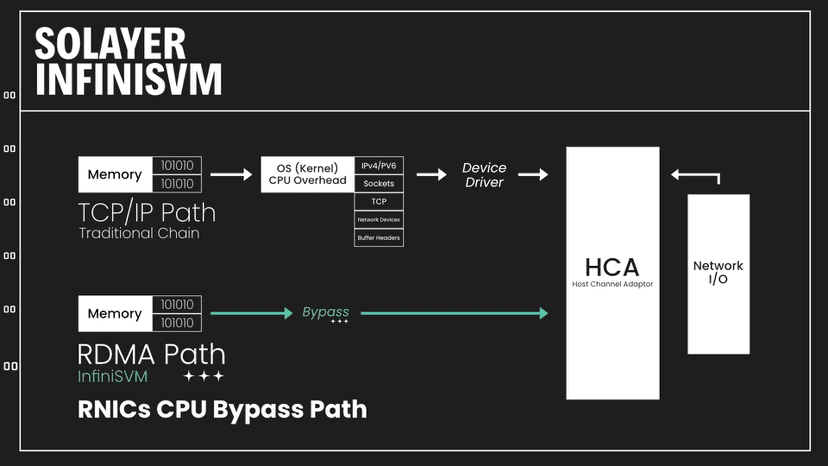To understand Solayer, first shift the perspective from 'a re-staking protocol' to 'a high-performance computing system centered around SVM'. Official documentation defines it as 'the hardware-accelerated SVM blockchain', aiming to sink some blockchain components into programmable chips, combined with a network stack of SDN/RDMA/InfiniBand, to create a parallel architecture of 'multi-execution clusters'.
The white paper and site statements provide two sets of intuitive scales: 1,000,000+ TPS and 100Gbps+ network bandwidth. These numbers cannot be achieved solely through software optimization; they require viewing the chain in terms of network, memory, and scheduling, much like HPC.
InfiniSVM is the core mindset of this system: it is not about 'maxing out' the existing SVM, but rather separating state and execution using multiple execution clusters, with clusters interconnected through high-speed networks, reducing tail latency caused by traditional 'single execution domain congestion'.
The site and application pages emphasize the 'infinitely scalable multi-execution cluster architecture' more than once, while The Block distilled it in early 2025 as 'hardware-accelerated chain based on SVM'. In other words, Solayer is not 'fast DeFi', but reconfiguring SVM + hardware acceleration + network into an execution base aimed at high-concurrency business.
Where does hardware acceleration specifically fall? The white paper provides two paths: first, sinking the verification and partial execution paths into programmable hardware to reduce the bottleneck of signature verification and state read/write on the CPU side; second, leveraging RDMA/InfiniBand at the network layer for direct 'zero-copy' distribution of transactions and blocks, improving inter-cluster synchronization and arbitration efficiency. For developers, this means that under congestion scenarios, latency is more predictable, not simply relying on 'increasing block size and relaxing fees' to change throughput.
Composability has not been sacrificed. Solayer still organizes the execution environment around SVM, which means that existing Solana toolchains and contract paradigms can be migrated; at the chain level, it also provides post-logical interfaces like 'Hooks' that embed actions like arbitrage, clearing, and accounting into the transaction lifecycle. For latency-sensitive businesses like order book DEXs, real-time clearing, and on-chain quotes, Hooks make 'reaction' a part of the system rather than an external script.
Performance is not the goal, but rather providing a settlement and verifiable high-speed channel for re-staking and the security market. The project page on CMC clearly states Solayer's self-positioning: through hardware acceleration and network bandwidth, reducing latency to support near-real-time applications; this is fundamentally different from protocols that 'only stack yields'. When doing research, pulling out engineering metrics like 'throughput/bandwidth targets', 'execution cluster parallelism', and 'transaction tail latency', avoiding purely emotional explanations, will provide more clarity.
The ultimate goal of the real-world Laton is to return to the user side: on the dense trio of settlement/matching/clearing, the combination of hardware and network can bring a consistent experience. When you retain the tools and ecosystem of Solana while replacing the execution side with 'multi-clusters + hardware', you neither lose composability nor push the performance ceiling upwards. This is the fundamental difference between Solayer and the past 'parameter tuning' scaling solutions. @Solayer #BuiltonSolayer $LAYER
